Analysis of the characteristics and frequency for the annular water-air self-excited oscillation jet pump*
2014-09-06XiaogangDENGXianmingZHANGXiongZHOU
Xiao-gang DENG, Xian-ming ZHANG, Xiong ZHOU
1Engineering Research Centre for Waste Oil Recovery Technology and Equipment, Chongqing Technology and Business University, Chongqing 400067, China;2Department of Mechanical and Power Engineering, Chongqing University of Science and Technology, Chongqing 401331, China
Analysis of the characteristics and frequency for the annular water-air self-excited oscillation jet pump*
Xiao-gang DENG† 1,2, Xian-ming ZHANG1, Xiong ZHOU2
1Engineering Research Centre for Waste Oil Recovery Technology and Equipment, Chongqing Technology and Business University, Chongqing 400067, China;2Department of Mechanical and Power Engineering, Chongqing University of Science and Technology, Chongqing 401331, China
Abstract:Due to the defects of low energy transfer efficiency and high residuary pressure in the water-air two phase jet pumps, the concept on the annular water-air self-excited oscillation jet is proposed to combine the advantages of annular jet and self-excited oscillating jet. The conservation of momentum and continuity equations have been obtained based the theory of annular jet. The flow field of the annular water-air self-excited oscillation jet is numerically solved by using the Realizable k-ε turbulence model and the Euler multiphase model, respectively. The performance parameters of the annular water-jet self-excited scillation jet pump such as pressure ratio h, efficiency η and flow ratio q are calculated. The basic performance curve has been obtained as compared with an ordinary annular water-air jet pump. The unsteady fluid average velocity at the down nozzle has been calculated, and the pulse frequency has been obtained. The results show that the entrainment capability could be enhanced by the annular water-air self-excited oscillation jet as compared with the ordinary annular water-air jet and the average velocity of fluid at the down nozzle has a significant pulse frequency.
Key words:Self-excited oscillation jet, Water-air Jet, Frequency analysis
1.Introduction
Water-air jet pump is a kind of fluid machinery designed to take advantage of high-velocity jets with pumped air for the fluid transportation and mixed reaction to create or maintain a low vacuum condition. Through entrainment of high-velocity water jet with air, the momentum could be passed to the ejected air to complete an exhaust process[1]. Inside the jet pump, it is possible for the water-air two-phase turbulence to generate higher entrainment effects on the ejected air to improve the efficiency of energy conversion. Once it is succeeded, it will have important theoretical and practical significance to promote the application and development of high-performance water-air jet pump equipment.
Depending on the different ways of entrance between the working fluid and the entrained fluid, a jet pump may work with its work jet that can be divided into three categories: center jet, multi-nozzle focus jet and annular jet. An annular jet requires a contact area between the working fluid and entrained fluid, which is much greater than that of the central jet under the same working conditions. Therefore, it is quite possible for the annular jet, within a short time, to complete the mixture process, and the following energy and momentum exchange with high efficiency which is much higher than that of a central jet pump[2]. Relative to the center jet, however, the global academic community seems to have made less progress in the studies of the multi-nozzle and annular nozzle jets. Nonetheless, Crow[3] performed the analysis and experimental research of the multi-nozzle performance model and the jet pumps at high entrainment ratio, and found that the multi-nozzle jet could be well utilized to significantly improve the energy transfer efficiency of the jet pump. Vanierschot[4] discovered the inhomogeneity that exists in annular turbulent flow field, and at the location near the downstream stagnation point, there was a central toroidal vortex (CTV), which intensified the velocity pulsation. This feature makes the annular jet more likely to be unsteady, and it was viewed as one of the main reasons to increase the momentum transfer efficiency of water-air fluid. The Chinese scholars Lu[5], Wang et al[6] revealed that the pulse jet was in a situation to help the fluid mix at the main outlets, obtaining an energy conversion efficiency being significantly higher than that of the steady jet pump. Therefore, their research process involved the use of an outside excitation source with a forced excitation to generate a pulse jet, leading to an increase in the complexity of the system.
An excitation source is not required for the self-excited oscillation pulsed jet, nor any of moving components. Relying on its nozzle structural characteristics (self-excited oscillation chamber and special boundary conditions), it is able to convert the nozzle jet into an oscillation pulsed jet[7]. In spite of the fact, the engineering applications tend to enhance the effect of the impact crusher, and its use in enhancing the air-extracting effect and energy transfer efficiency is rarely reported.
Available experimental results[8] showed that the self-excited oscillation pulsed jet worked impressively, in an oscillation chamber, to improve the mass of air transmission and the efficiency of energy transfer. Based on the theory on the jet pump and self-excited oscillation pulsed jet, the combined advantages of both the annular jets and the self-excited oscillation jets have proposed to the idea of an annular water-air vacuum pump based on the self-excited oscillation pulsed jet. Subsequently, the relevant numerical simulation studies have been made on the basic performance and oscillation frequency.
2.Annular water-air jet pump: model of self-excited oscillation
2.1.Basic equation for annular water-air jet
Due to the presence of a significant velocity difference between the water and air two-phase flows in the pump and a large density difference between them, the movement of the mixed-phase boundary surface could be quite complex. Meanwhile, the two-phase flow may have different medium flow parameters, and coupling can also be found on the boundary surface: a mutual drag role from the air phase and liquid phase helps to complete interphase energy transfer and mass transfer process.
After an annular jet enters the entrainment chamber, the water and air phases are to form a pure annular flow: with the central part of the air phase, the two-phase flow leads to the formation of a ring-shaped liquid film. Here the microtubule segment is set with a lengthδl, and cross-sectional areaA. On the both sides, the pressure values and velocities of the phase separation are shown in Figure 1. The liquid phase is marked with the subscript ‘l’ , the air phase subscript ‘g’, and the air-liquid boundary surface parameters are expressed with the subscript ‘j’. Then, the law of conservation of mass is applied to the air flow to obtain the continuity equation as follows:

(1)
Where,vgandvlare the velocity of the air and water phases, respectively.ρgandρlare the air phase and water phase densities,Ais cross-sectional area,φis the rate of air contained in the mixed phase.

Figure 1.Parameters of the annular jet microsegment
The momentum equation of mixed phase:

(2)
QmgandQmlare the mass flow of air and water, respectively;τljindicates the tangential stress in air phase acted on the liquid ring.Xis the average humidity of air phase.
2.2.Calculation of jet efficiency
Flow and pressure of the annular water-air jet are taken into dimensionless processing:

(3)


(4)
As the working liquid is acyclic, the efficiency of the annular water-air jet with self-oscillation could be calculated as follows:
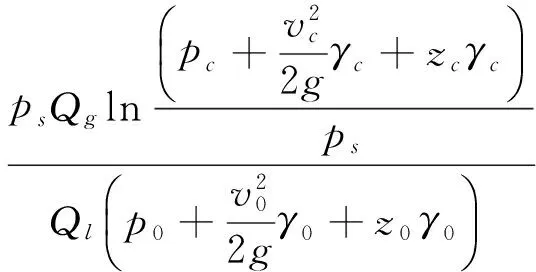
(5)

2.3.Physical model
The jet pump structure is shown in Figure 2 (a). The working water jet is ejected from the annular nozzles at an inclination ofα, flowing through the upper nozzle into self-oscillation chamber, followed by the formation of a mixed phase boundary surface with cyclic water-air. Inside the oscillation chamber, the annular jet is fully developed, making the mixed phase boundary surface no longer visible. The mixed jet impact against the wall to get shunts, with a small amount of fluid to form vortexes in the self-oscillation chamber, which is fed back to the upper nozzle. Self-oscillation pulse chamber is designed with the inherent side wall conditions, which helps to complete the feedback, selective amplification of the pressure disturbance wave, the process of resonance in the two-phase flow annular shear boundary layer. As a result, the fluid at the lower nozzle is modulated into a strong pulse jet. The structural parameters of each part are shown as below.
The ordinary type of annular jet pump is structured as shown in Figure 2 (b)[9]. The pipe, as the main place for water-air mixing, requires a relative long size to complete the water phase and air phase momentum exchange. An annular jet pump may have its axial dimension much greater than that of an annular jet pump based on self-oscillation.

Figure 2.Structure diagram of jet pump and the contrast
3.Numerical simulation
Here are taken a group of the optimal combination of structural parameters (upper nozzle diameterd1=40 mm, the diameter of the air inletd/d1=0.875,the upper and lower nozzle with diameter ratiod2/d1=1.5, the chamber diameterDc=100 mm, the chamber aspect ratioLc/Dc=0.45, annular jet inclinationα=15°, the optimal structure parameters are calculated in another paper). The Gambit software is introduced to establish an axisymmetric annular water air jet pump based on the self-oscillation pulse and a grid of annular water-air jet pump. By contrast with the annular water-air jet pump, the parameters at the same parts are the same with the annular water-air jet pump with self-oscillation. A pipe is used to replace the self-excited oscillation chamber, whose length is 150 mm[9], as shown in Figure 2. The grid is more denser near the wall as compared to the center region of computational domain. Once the mesh file is obtained, the fluent with Ansys13.0 is adopted to simulate the numerical model, in which an eulerian multiphase model and realizablek-εTurbulence model are applied. The inlet of water jet is for velocity, and the air inlet for ventilation.
Simulation is carried out in two states: steady and transient. In the steady state, the calculation includes the adjustment of the velocity at the water jet inlet, changing the flow of the annular water jet ejected into the pump and the air intake flow at the air inlet, while recording the pressure at the entraining inlet, the total pressure of water inlet and the total pressure of the outlet, thus to obtain the flow ratioq, pressure ratioh, and the efficiency of the jet pumpη. In the transient state, time step is set as 1×10-4s and influent flow as 7.52×10-3m3/s, and then the average velocity of the water and air phases at the lower nozzle are obtained, followed by frequency analysis.
3.1.Flow ratioq
Flow ratioqchanges with the incident flow of the annular working jet, its curve is shown in Figure 3. For the annular water-air jet pump with self-oscillation, the flow ratioqdecreases as the working jet flow increases. Therefore, in practical situation, the influent flow is required to ensure that the better entraining effect will be achieved, with energy consumption to be controlled within the acceptable range. Comparatively, the ordinary annular water-air jet pump has a flow ratio q that is approximately 60% of the former one. In the same input conditions for a working jet flow, an annular jet pump based on the self-oscillation could have more superior entraining capacity.
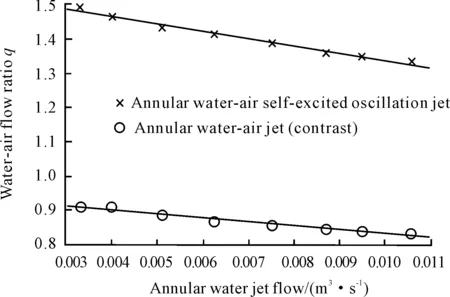
Figure 3.Relationship between flow rate of annular jet flow ratio q
3.2.Basic performance curveh-q
Jet pump performance curves (hq) can be viewed as characteristics for the jet pump pressure and flow relationship, reflecting the impact of changes in energy on the jet pump performance. This is the theoretical basis for the design, manufacture and application of jet pumps.
The basic performance curve of a jet pump is shown in Figure 4. Theh-qcurve encloses an area as the characteristics of a range that allows a jet pump to work within. Compared to an annular water-air jet pump, its basic performance curve is below the former curve, indicating the annular jet pump with self-excited oscillation has a better performance.

Figure 4.Basic performance curve h-q
3.3.Jet pump efficiencyη
Annular self-oscillation jet pump gives aq-ηas indicated in Figure 5. Efficiencyηdecreases with the increase of flow ratioq.The highest efficiency could reach up to 30%, whereas the efficiency of an annular water-air jet pump is much less than that of the former one. This is resulted from a self-oscillation role that increased the energy exchange between the water and air, and subsequently, the formation of a periodic excitation in the oscillation chamber. At the lower nozzle, the mixed phase is modulated into a pulse jet, which is effective to improve the efficiency of a jet pump. On the other hand, the use of a self-oscillation chamber to substitute the throat pipe of the traditional jet pump can prevent the water and air mixture jet from a sudden increase in pressure. Namely, this mixed segment is similar to a traditional jet pump pipe in which it could be avoided, thus the efficiency could be improved.
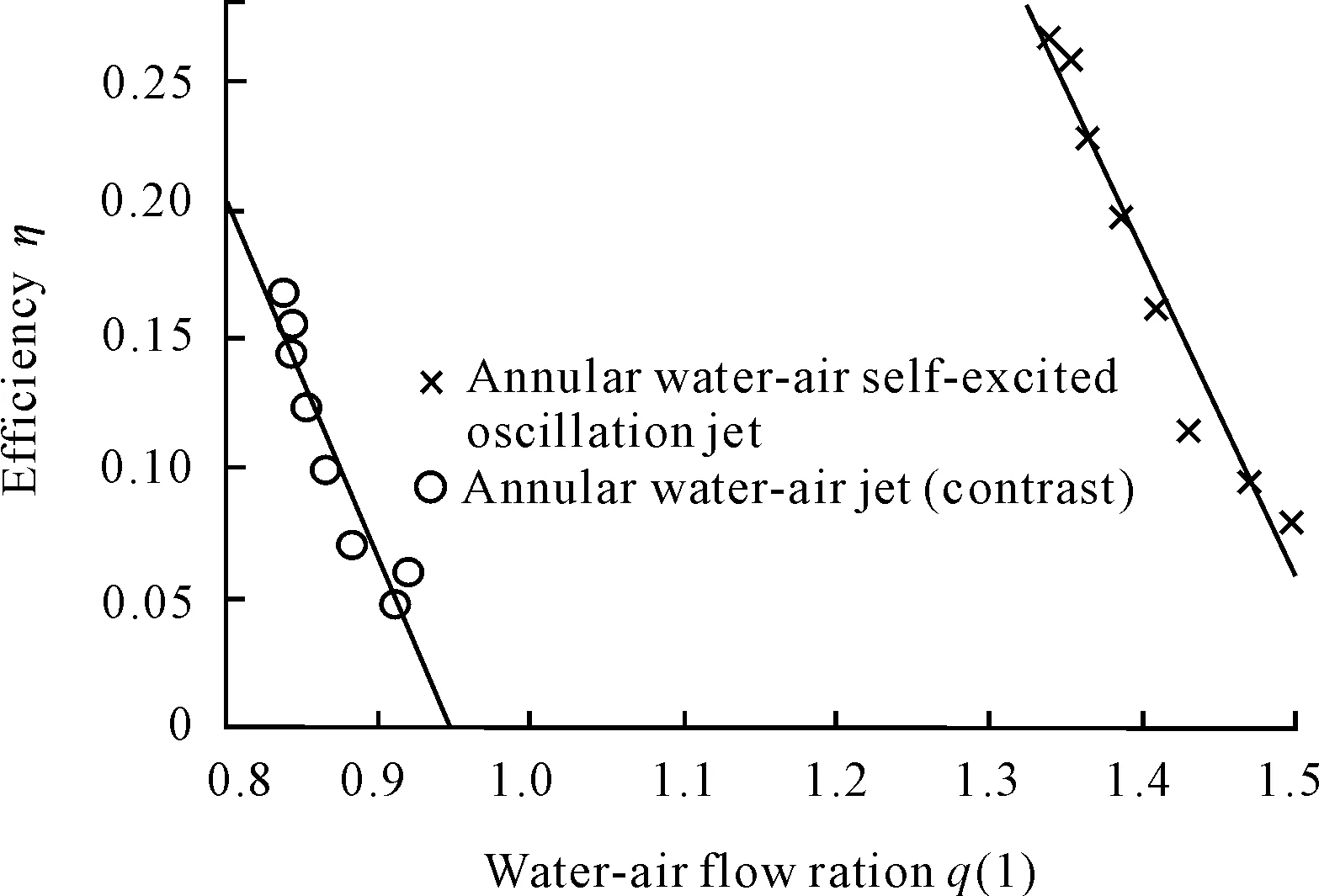
Figure 5.Relationship of water-air flow ratio q and the efficiency η
3.4.Self-oscillation frequency analysis
Being ejected from the annular gap nozzle, working jet entrains the air enclosed in the ring to form an annular water-air jet coming through the upper nozzle of the oscillation chamber to be ejected into the self-oscillation chamber. Annular high-velocity jet and the air inside and outside the fluid ring are combined to generate an entrainment, and a very unstable shear layer is formed in the ring plane. Shear jet, within a certain frequency range, could be regarded as the vorticity disturbance being enlarged in the chamber, followed by a collision with the downstream wall to generate the pressure disturbance waves, which are reflected to upstream, where in return, the vorticity disturbance is again induced. The process is repeated to ultimately convert the fluid spray from the lower nozzle into a strong pulse jet.
Transient calculation results show that the annular water-air jet pump based on self-excited oscillation works with the water-air phases at an average velocity that is plainly pulsing at lower nozzle. In about 0.7 s after annular jet enters the self-oscillation jet pump body, the air coming through the lower nozzle may present an average velocity that features kind of a pulsation. Compared to the ordinary annular water-air jet pump, the inlet of the diffuser pipe has an air velocity without many significant fluctuations, as shown in Figure 6. This may be resulted from the annular jet, after entering the self-excited oscillation chamber, the circular water-air mixture shear layer range is constantly expanded, and the mixed phase boundary surface tends to blur. Under the entraining action of the working liquid, air will get accelerated constantly and becomes part of the self-oscillation process that involves collision - feedback - resonance, and ends up being modulated into a pulse water-air jet at the lower nozzle.
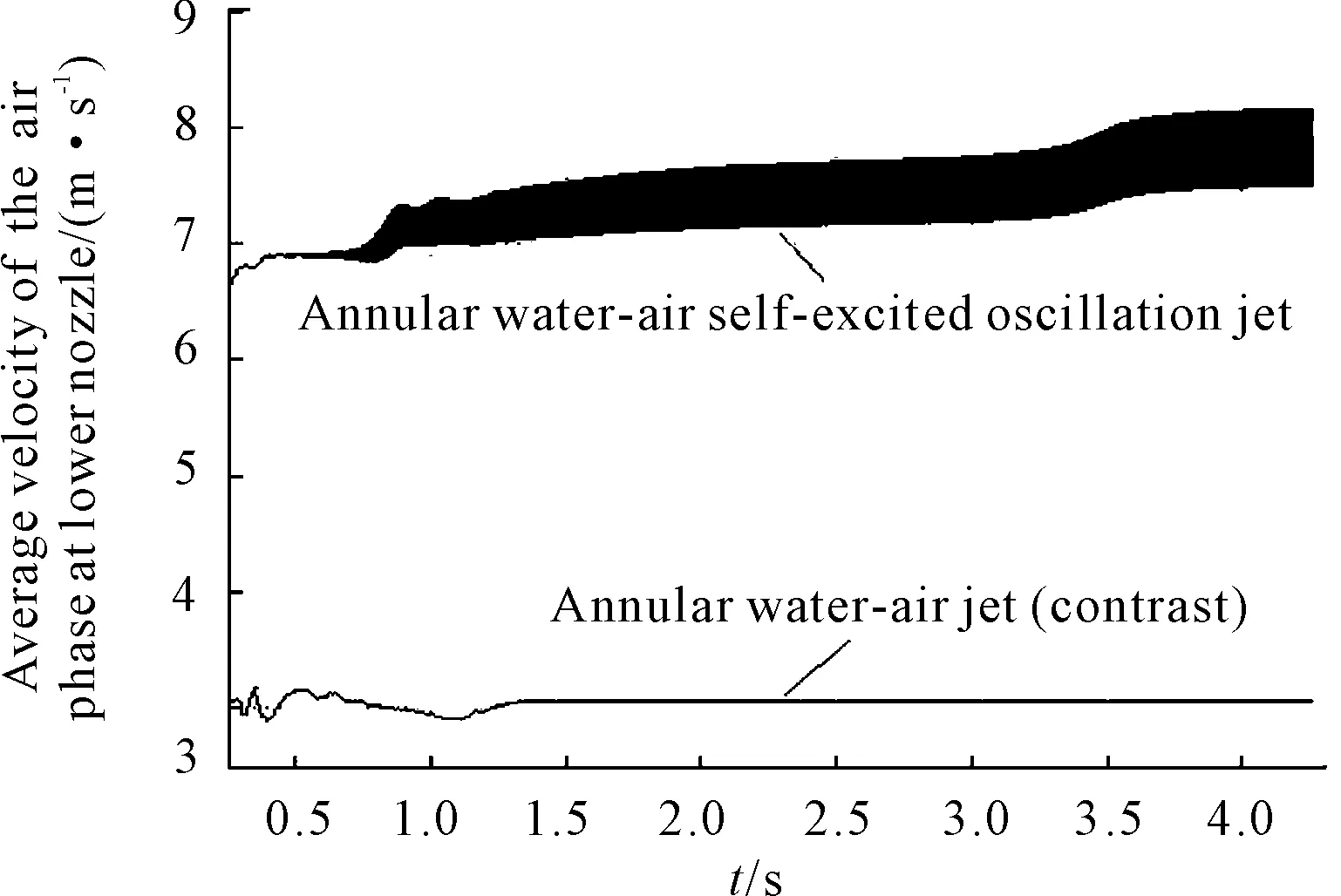
Figure 6.Oscillation changes on average velocity of the air at lower nozzle
In contrast, at the inlet of the diffusion tube, the ordinary annular water-air jet has an air phase average velocity that is far smaller than the corresponding rate of a ring-shaped water-air jet with self-excited oscillation at its lower nozzle. This is because that inside self-oscillation cavity, annular water-air mixing jet is likely to get full development in the unconstrained state, whereas the annular water-air jet is, in the long pipes, subject to wall constraint and friction effects, being favorable in a smaller energy loss and a greater average fluid velocity. This also shows that an annular water-air jet with self-oscillation can be more superior in entraining air.

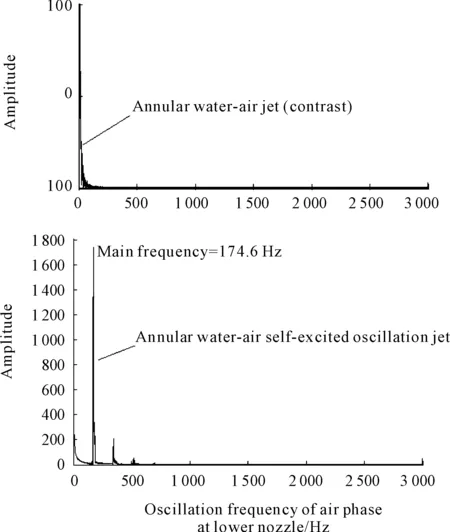
Figure 7.Oscillation frequency of the air phase velocity at lower nozzle
4.Conclusion
In this paper, the numerical simulation method is applied to investigate the fluid flow inside pump with different work jet flow ratios, including flow ratioq, pressure ratiohand the efficiency of the jet pumpη. Annular jet pump in water-air with the self-excited oscillation pulse is analyzed in terms of its basic performance and frequency characteristics. Some conclusions could be made as follows.
1) Under the conditions of the same parameters for work jets, the entraining capacity and efficiency of an annular water-air jet pump based on self-excited oscillation are superior to those of an ordinary annular water-air jet pump.
2) The unsteady simulation results show that at the lower nozzle of the annular pulse jet with self-excited oscillation, the fluid average velocity can be found with apparent pulse oscillation, and it is greatly improved as compared with an ordinary annular water-air jet. This indicates that the annular water-air jet featuring self-oscillation has an enhanced entrainment capacity for ejector air, ultimately the water-air transfer efficiency will be improved.
3) At the lower nozzle, the fluid average velocity pulsation is highlighted with a main frequency. As the main frequency is in getting close to the natural frequency of the system, the oscillation amplitude is strengthened. Therefore, further efforts should be made in the studies of the relationships between structure parameters and the oscillation amplitude.
References
[1]Gao Juanchuang, Wang Yuchuan. Progress in the Application of the Water-Air Jet Pump[J]. Petroleum Machinery, 2008,36(2):67-71.
[2]Gazzar M E,Meakhail M S. Numerical Study of Flow Inside An Annular Jet Pump[J]. Journal of Thermo physics and Heat Transfer,2006,20 (4):930-932.
[3]Crow S C,Champagne F H. Orderly Structure in Jet Turbulence[J]. J. FluidMech,1971,46(3): 547-591.
[4]Vanierschot M,Van den Bulck,Eric. Experimental Study of Low Processing Frequencies in the Wake of A Turbulent Annular Jet[J].Experiments in Fluids, 2011,50(1): 189-200.
[5]Honglin K, Lu Hongqi. Theoretical Analysis of Pulsed Liquid Jet Pump Performance and its Numerical Calculation[J]. Hydrodynamics Research and Development, 2005.20(4):538-543.
[6]Wang Linghua, Zhu Jing.Numerical Research on the Functions with Throat Inlet of the Pulsed Liquid Jet Pump[J]. Rural China Water Conservancy and Hydropower, 2011.7:133-135.
[7]Chatterjee S. On the Efficacy of an Active Absorber with Internal State Feedback for Controlling Self-Excited Oscollations[J]. Journal of Sound and Vibration, 2010.330(7): 1285-1299.
[8]Deng Xiaogang. Experimental Study of Self-Excited Oscillation Pulsed Jet Aerator. EPPH 2011, 2011.5:260-264.
[9]Kwon O B,Kim M K.Two-dimensional Numerical Simulations on the Performance of an Annular Jet Pump[J]. Journal of Visualization, 2002.5(1): 21-28.
环形水气自激振荡射流频率数值分析*
邓晓刚† 1,2, 张贤明1, 周雄2
1重庆工商大学 废油资源化技术与装备工程中心,重庆400067;2重庆科技学院 机械与动力工程学院,重庆401331
摘要:针对水气两相射流泵传能效率较低、吸气残压过大的问题,结合环形射流和自激振荡射流的优点,提出环形水气自激振荡脉冲射流的概念。以环形射流理论为基础,推导了混合相界面上的连续性方程和动量方程。采用Realizable k-ε紊流模型和欧拉多相流模型对环形水气自激振荡脉冲射流流场分别进行了定常和非定常数值模拟。计算了环形水气自激振荡射流泵的流量比q、压力比h和效率η等性能参数,绘制出基本性能曲线,并与普通环形水气射流泵进行了比较;对下喷嘴处的流体平均速度进行了非定常模拟计算,通过现场实验测试,对下喷嘴处混合相瞬时速度脉冲进行了频率分析。结果表明:与普通环形水气射流相比,环形自激振荡射流对气体的卷吸作用能力增强,且下喷嘴处的混合相瞬时速度值具有显著的脉冲主频。
关键词:自激振荡射流;水空射流;频率分析
中图分类号:TH4
DOI:10.3969/j.issn.1001-3881.2014.06.019
Received: 2013-09-25
*Project supported by National Natural Science Foundation of China (General Program, No. 51376204), and the Natural Science Foundation of Chongqing (cstc2011jjA20013)
† Xiao-gang DENG, E-mail: yxydxg2002@sina.com
杂志排行
机床与液压的其它文章
- Control of EPS with regulating factor
- Numerical simulation of the double suction balance type screw compressor working process*
- Cam profile optimization design of variable cycle reciprocating piston engine*
- A Sort of fusion control strategy for uncertainty complex process with large time lag*
- Influence of salt fog test on the performance of the composite coating on avionics cases
- Flow field CFD analysis of axial flow blood pump*
